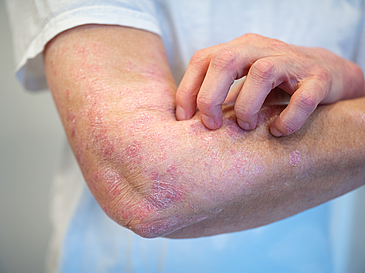In Germany, around seven million people suffer from chronic skin conditions such as eczema and psoriasis. These conditions cause high levels of distress, and in many cases, treatment with skin creams is not sufficient. Symptoms such as permanent itching can be treated most gently and cost-effectively by phototherapy – by exposing the affected parts of the body to specific light wavelengths.
However, many sufferers cannot integrate this therapy into their everyday lives due to the large time investment and organizational effort required, so they instead take medications that can cause significant side effects. The start-up Skinuvita, a University of Bremen spin-off, is about to launch a therapy system that can be used easily and safely at home.
A research cooperation with the Center for Computing Technologies (TZI) at the University of Bremen intends to make light therapy even easier to use and less susceptible to misuse in the future. The Computer Graphics research group headed by Professor Gabriel Zachmann wants to use artificial intelligence (AI) to enable automatic detection of body parts and to ensure that light is dosed optimally.
Until now, phototherapy has required the presence of dermatologists – three to six times a week in 30 sessions during a flare-up. Although the actual treatment only requires between 25 seconds and a maximum of 10 minutes, the patients’ time investment has included travel to and from the doctor’s office as well as waiting time, and was limited by the opening hours of the doctor’s office. For those in rural areas, single parents, and many employees, this is not feasible.
In order to make phototherapy accessible to all those affected, the start-up Skinuvita is currently developing technology to allow safe use at home, free of side effects. The digital therapy system is the first European solution to meet all guideline requirements for physician-accompanied home therapy. Components of the system include a therapy manager software for doctors, a patient app, and a Bluetooth control module for the therapy device.
A decisive change compared to the conventional approach is the digitization of processes that are currently still analog. The digital creation of therapy plans also allows the dermatologist to control the dosage remotely. Thanks to the Bluetooth control module, patients no longer need to input the dosage manually and a sufficient time interval between therapy sessions is ensured. Instead of 30 visits to the doctor’s office, only two are required – one at the beginning and one at the end of the therapy. In the meantime, the dermatologists retain full control.
Automatic Detection of Body Parts and Skin Redness
As part of the joint research project, Professor Zachmann’s TZI research group is now developing automated image analysis methods to facilitate the safe use of the device. One goal is the automatic detection of body parts. This way, the system can prevent treatment of the wrong surface as well as multiple treatments of the same area. Measuring the right distance between the lamp and skin is also important.
It is also plausible to develop LED lights that automatically adjust exposure to only the affected areas and not the entire body part. Another task that AI can assist with is the precise detection and classification of skin redness. “So far, users have been assessing what their skin looks like,” reports Judith Boeckers, research associate of the TZI Computer Graphics research group. “But what one person classifies as intense red is pale for another.” Even for the attending physicians, this distinction is not easy to make from submitted photos, because the lighting conditions of the images often vary. AI can help with image processing and color matching here.
“We want to look ahead at ways to make medical care even better with the help of intelligent data use,” adds Skinuvita CEO Jan Elsner. One central question is how smartphones can be used to make the treatment more effective.
The development of the first version of the system is now almost complete – the results of the research project will be incorporated into the further development. A clinical study with over 600 completed therapy sessions has so far revealed no safety problems. “As expected, adherence to therapy is higher than when people have to go to a doctor’s office,” reports Elsner. “More patients continue the therapy without stopping. At the same time, the quality of life increases significantly.” The approval process is now nearing completion, so the system could be on the market this fall.
Bremen State supports the research cooperation between the University and Skinuvita within the framework of the “Promotion of Research, Development, and Innovation” (FEI) program.
Contact:
Judith Boeckers
Center for Computing Technologies (TZI)
University of Bremen
+49 421 218-63994
ju_bouni-bremen.de
Carolina Idzior
Skinuvita
carolina.idziorskinuvita.de
Further Information:
www.tzi.de
www.skinuvita.de
cgvr.cs.uni-bremen.de
www.uni-bremen.de/en

